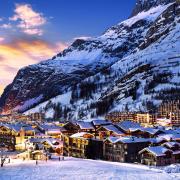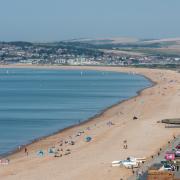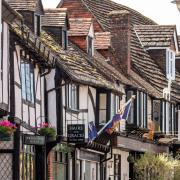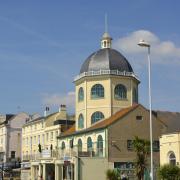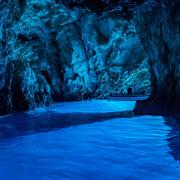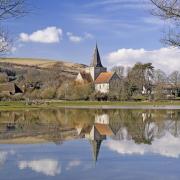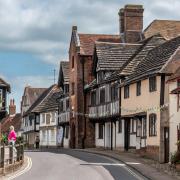They’ve starred in some of Hollywood’s most iconic movies including Harry Potter, Foyle’s War, and Atonement and have inspired countless lines in literature but after the latest rockfall in April eroded yet another section of the historic Seven Sisters, there are growing fears that the next big storm could see the world-renowned Coastguard Cottages at Cuckmere Haven literally fall off a cliff edge.
The iconic picture postcard image – overlooking the beach where Guy Fawkes landed and Queen Victoria used to walk – risks being lost to the elements before campaigners can finalise their plans to shore up the defences and keep the sea at bay.
Now environmentalist Angela Terry is warning: ‘You can’t hold back the sea and the level is rising with more extreme weather. We're not talking about it enough you don't know what you have got until it's gone.’

There were more than 50 large cliff falls across Sussex in the last year and the Maritime and Coastguard Agency said pieces falling from them ‘can be just a few small rocks or as large as a car’.
Ironically, it is the accelerating rate of coastal erosion – hastened by the wild weather effects of climate change – that add to the beauty of the cliffs as each layer of rock lost exposes a new patch of chalk and its instantly recognisable startling white hue.
But it is that same towering magnificence which risks being dwarfed in batterings from increasingly ferocious waves below and torrential rain above – with no Government funding available to foot repair bills or compensate property owners if or, as is increasingly likely, when they fall victim to the harsh conditions and crash several metres into the sea.
Angela, the environmental scientist with One Home Climate Solutions, a national charity seeking to help people cut bills and cut carbon, told Sussex Life: ‘It's a perfect storm of injustice. If a house or business is falling into the sea there's no government compensation yet we have energy companies making millions of pounds a week from burning oil and gas which causes climate change when people in coastal areas are the ones facing financial hardship due to its effects.’
‘We have amazing historic features we're looking at losing. We need to be talking about it more - these beautiful cliffs are national symbols. The sewage issue in our seas is now being talked about but we can clean that up with more careful waste water management ¬- we can't turn down the temperatures.’

With erosion levels along the Sussex coastline dramatically increasing in recent years from 0.3m a year to between 0.6m and 1m, she said: ‘We're not prepared for how fast our coast is changing and it's only going to accelerate.
‘We need a coastal minister and compensation for climate refugees - the people whose homes will be demolished and have to pay for the demolition of their own home.’
At risk are the six Coastguard cottages, seen the world over, and now perilously close to the cliff edge – those nearest are just 10m away while those furthest away are 20m. More than one third of the land area below the cottages has been swept away in the last 100 years.
One supporter of the Cuckmere Haven SOS charity, created to preserve the defences of Cuckmere Haven West Beach and Cliffs designed to protect the cliff top landscape and the cottages, Lucy Mutter, said one of her great-grandfathers John Ayres was the last coastguard officer stationed there, and another great-grandfather Albert Smelt enjoyed holidaying there with his family. It was the latter that bought the cottages when they were decommissioned in the early 1920s and were put up for auction.
‘We maintain these structures as best we can, but due to changing government funding, and changing tides, we are now more vulnerable than ever,’ she warned.

The charity is in the final throes of drawing up a private planning application to shore up the cliff face defences so they continue to protect the cliff top, thus granting the cottages and historic cable hut a reprieve of up to 30 years. Earlier plans were thrown out for having too great an impact on the environment as they involved developing new sea defences over a chalk reef of international environmental importance that is home to crabs, mussels and oysters and a rare seahorse.
The latest proposals, to repair a damaged section of a retaining wall currently exposed to the elements, are set to go before planning officials at the South Downs National Park at the end of this year. A public fundraising campaign has secured almost £100,000 in donations to bankroll the protective plan being drawn up by engineers.
If successful, the charity will seek similar funding support to finance the actual repair work which could start as early as next year.
Chair of the charity’s trustees, Professor Michael Davies, told Sussex Life: ‘The area means a lot to people - it's important in terms of both people and landscape so our work is for both the natural and human environment.
‘It will have a minimal environmental impact and will actually create new habitat on the beach with rock pools.’

The group has been working with the Maritime Agency, Environment Agency, English Nature and English Heritage as it devises its plan.
‘The area is a big tourist draw,’ Professor Davies continued. ‘The campaign has lots of layers and interest from the spiritual to the economics of the region.’
The charity’s website warns people: ‘The next storm could see this world-famous haven lost forever. We need to act now. ‘Cuckmere Haven and the Coastguard Cottages are running out of time.
‘Over one third of the land area below the cottages has been swept away. The next storm could see this iconic view lost forever.’
The site enjoys ‘something of a global superstar status,’ says the site, highlighting the fact that numerous films, commercials and TV shows and commercials, including BBC drama Luther, feature the magnificent cliffs which are both a designated Area of Outstanding Natural Beauty (AONB) and designated Site of Special Scientific Interest (SSSI).
Charlotte Owen, Communications Officer at Conservation Sussex Wildlife Trust, explained that the South Downs form one of the most important chalk landscapes in England.
‘The underlying geology is strikingly visible along the spectacular Sussex coastline, with its famous white cliffs,’ she said. ‘They are formed of chalk laid down as sediment from the microscopic remains of plankton some 90 million years ago.
‘Chalk is a soft and porous rock, easily worn away by the waves and weather, and the cliffs are naturally unstable due to constant coastal erosion. This is what keeps the cliffs looking so white, as fresh chalk is constantly exposed. As a result, the chalk coastline is dynamic and has been retreating gradually over thousands of years’ exposing ‘an incredible patchwork of habitats that so many species call home.’
Kittiwakes and Peregrine Falcons breed there and the endangered Potter Flower Bee excavates nest burrows in the sandy soil.
‘Erosion is a natural process that cannot be managed, so instead we accept and allow for free-functioning coastal cliff erosion so that the wildlife populations associated with the cliff, undercliff and cliff-top habitats are maintained,’ Charlotte said.
Alinah Azadeh, a local writer, performer and cultural activist, and the first ever writer-in-residence at Seven Sisters Country Park / Sussex Heritage Coast (2020-23) for the South Downs National Park, led We See You Now, a landscape and literature programme, exploring the coast through the lens of climate change, empire, loss, migration and belonging.
This led to We Hear You Now (WHYN), an audiowalk series of poetry, fiction and myth by Alinah and 10 fellow writers of Black and global majority heritage, now installed on Listening Posts across the coast and online, co-funded by Arts Council England.
She said the area has always been an inspiring place for artists and writers. ‘It is special visually but also being up high - it's like being close to something way beyond human that's ungraspable. People treat it as a pilgrimage site and as a piece of cultural heritage it is unparalleled. It's the rawness of the elements and people have a romantic notion to live there but could they really?
‘Wildlife is adaptive and some actually thrive on what the falls expose with new species of flowers coming back - until it hits people on a personal level climate change is hard for people to get their heads around.’
Excerpts from the WHYN audio trail explore the intrigue the cliffs hold for visitors: ‘The coastline here became increasingly elusive, and access grew more perilous. But still many came, drawn to the crumbling beauty of the chalkland edge, watching it turn the sea milky at intervals, its outer crust melting back into its mother’s watery womb, and finding relief and refuge in the wide, marine horizon beyond.’
Owners of the Coastguard Cottages are hoping for a warm summer as it’s the relentless bad weather that hastens coastal erosion. Over time cracks form within the chalk cliffs and the constant lashing from the wind and rain drive the moisture further into the cliff face. In wintry conditions, the water in the cracks freezes and expands, enlarging the cracks and eventually turning them into fissures which then weaken the cliff until there is another cliff fall.
Experts believe, for example, in around 40 years the Birling Gap Hotel, which began life some 100m from the cliff edge, will start to topple off and in around 90 years the entire cliff face beneath it will have disappeared. That’s why work has already started to demolish sections of the building such as its ice cream parlour as The National Trust named Birling Gap as one of their ‘coastal hotspots’ at risk from climate change in the UK.
Dr Dylan Rood, from the Department of Earth Science and Engineering at Imperial College London, said: ‘The coast is clearly eroding, and Britain has retreated fast. Our study on British coasts leaves no question that coastal cliff retreat accelerated in the recent past. A nearly ten-fold increase in retreat rates over a very short timescale, in geological terms, is remarkable. The UK cannot leave the issue of cliff erosion unresolved in the face of a warming world and rising sea levels. Cliff erosion is irreversible; once the cliffs retreat, they are gone for good.’
And in a haunting warning of climate change and the forces of nature, the WHYN soundtrack predicts, ‘…the sea, the wind, the heat, the cold. What shapes the land will shape us too’.




